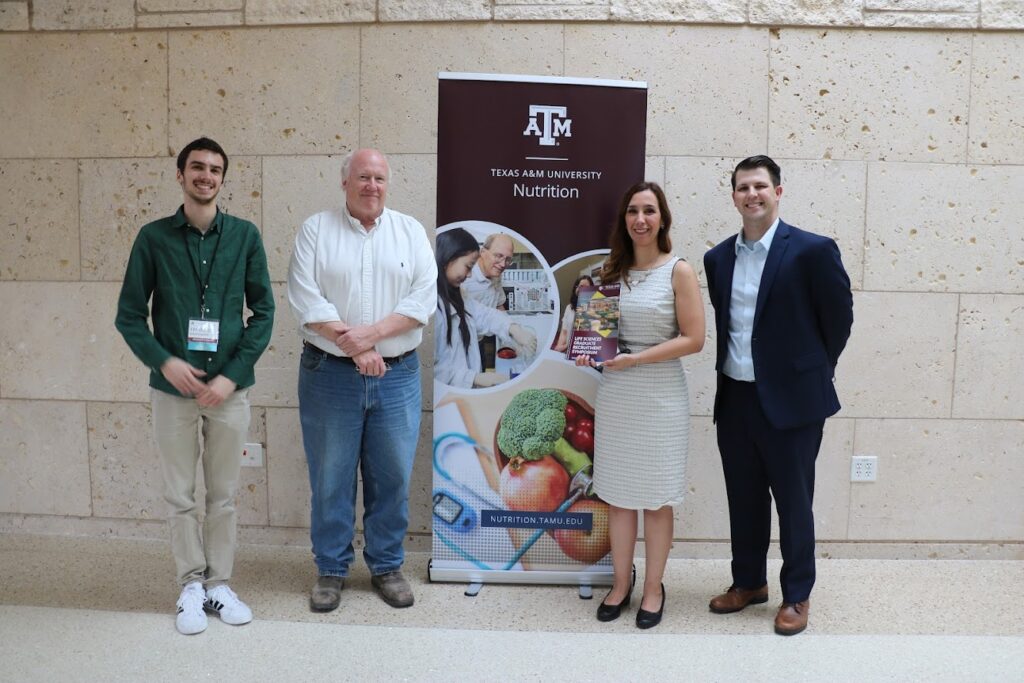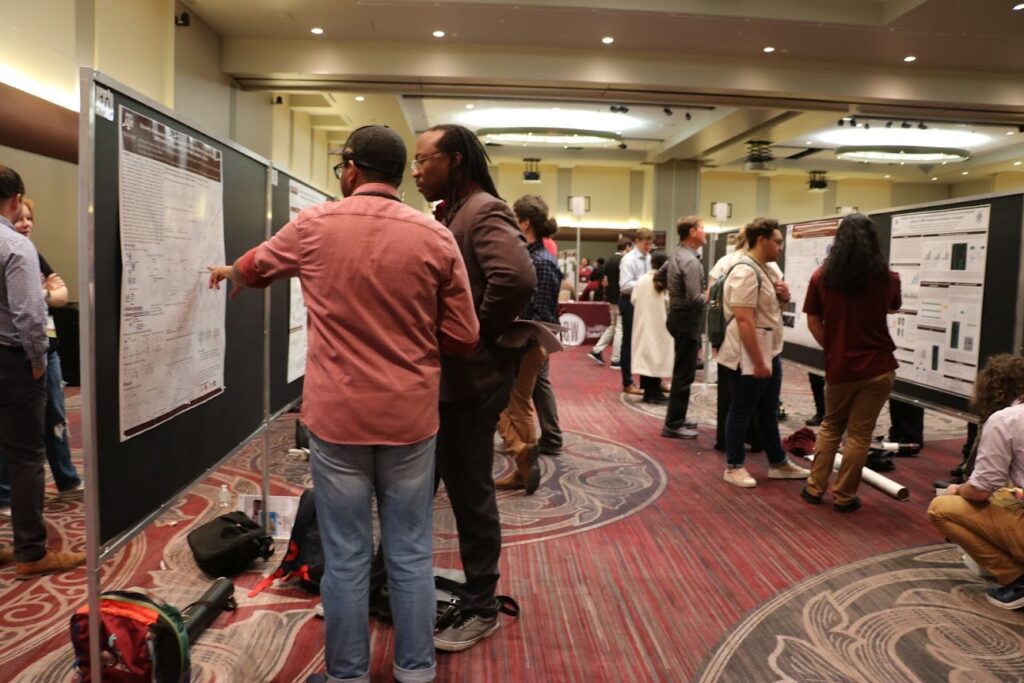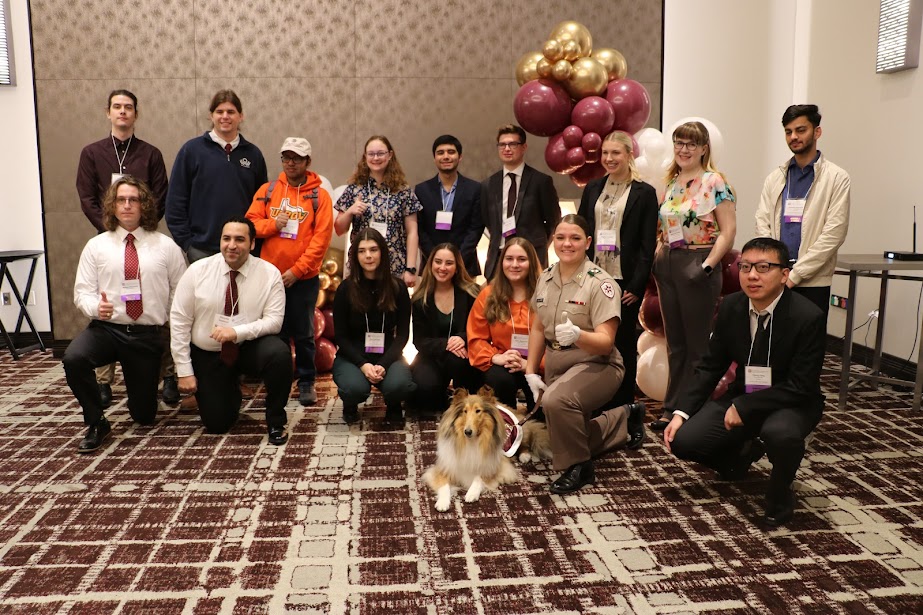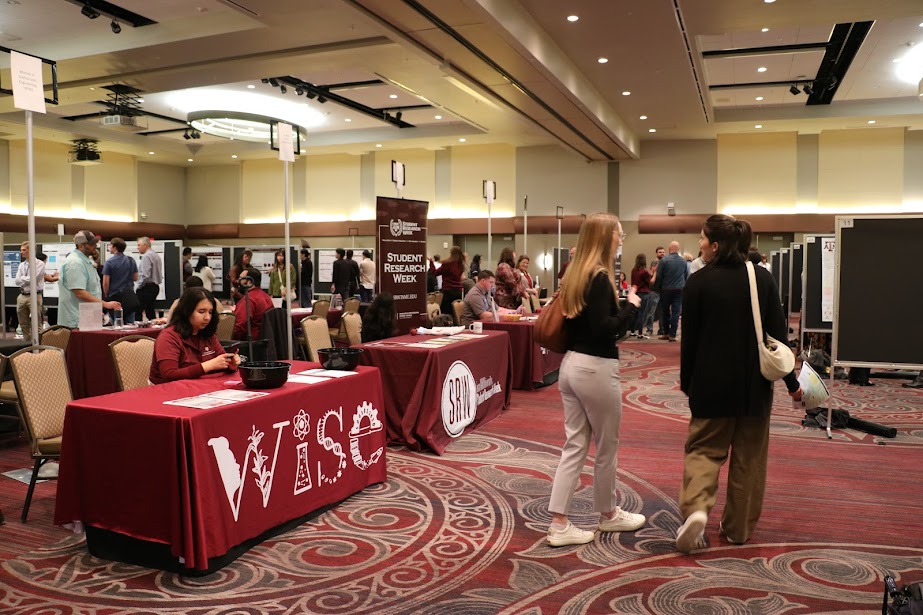Life sciences doctoral programs highlighted at Texas A&M symposium
Introduces Ph.D., graduate candidates to life science programs, student benefits, more

Six Texas A&M University life sciences graduate programs recently collaborated to present the 2024 Life Sciences Graduate Recruitment Symposium on the Texas A&M campus.
About 100 prospective graduate students and 300 faculty, staff and current graduate students attended the Feb. 2 symposium, which introduced aspiring Ph.Ds. to the various life science programs at Texas A&M, the research enterprise and the many benefits of attending Texas A&M.
The symposium showcased the programs of Biochemistry and Molecular Biophysics: Genetics and Genomics; Medical Sciences; Neuroscience; Nutrition; and Toxicology.
Each program is part of the university’s Life Science Network.
About the symposium
”The main purpose of the event is to recruit students pursuing admission into one or more of these doctoral programs,” said Ximena Paez, Ph.D., associate department head for administration in the Department of Nutrition, who has organized the symposium the past four years. “Some students who attended were already undergraduate students at Texas A&M, while the majority were prospective candidates from various universities throughout the U.S.”
Many of the newcomers arrived on campus a few days before the symposium to tour the campus and learn more about the life science program or programs to which they had applied.

The pooled resources of multiple participating graduate programs allowed them to not only showcase the breadth of life science research at Texas A&M, but also student resources to improve the graduate student’s learning experience, particularly for those from resource-limited institutions.
“We showed attendees many of the outstanding student services and opportunities that are available to students at Texas A&M,” Paez said. “In previous years, we have received an outpouring of positive feedback from attendees, and all our life sciences programs have had a significant increase in acceptance and enrollment rates compared to previous years when programs hosted individual recruitment events. A joint recruitment effort such as ours sets us apart from other institutions.”
She also noted that the symposium offered a unique chance for current graduate students and faculty from across campus to get together and discuss potential scientific collaborations and mentorship opportunities.
“The symposium serves as a catalyst for interaction among members of different programs and departments who may not typically engage with each other,” Paez said.
The symposium was made possible by support from the Texas A&M Graduate and Professional School, the various colleges that house these life sciences programs and the university’s Division of Research.
Symposium activities, presentations

Prospective students heard remarks by Fuhui Tong, Ph.D., interim associate provost and dean of the Graduate and Professional School. There was also a special guest appearance by Texas A&M’s mascot, Reveille.
They also participated in a poster session showing the research of students currently in the life sciences programs and listened to 18 short thesis talks by select graduate student representatives from each program.
The symposium wrapped up with an evening keynote address by Manu Platt, Ph.D., director of the National Institutes of Health-wide Center for Biomedical Engineering Technology Acceleration, also known as the BETA Center.
Benefits of the symposium
“The symposium provided an opportunity for prospective graduate students to explore each program across the university-wide life science enterprise to determine which might be best to meet their academic interests and career aspirations,” said David Threadgill, Ph.D., head of the Department of Nutrition in the Texas A&M College of Agriculture and Life Sciences and a driving force behind the symposium since its inception.
“Some of our life science programs are smaller and showcasing all of the programs gives the attendees a better chance to know about these programs as well as our larger ones,” Threadgill said. “The symposium gives those representing the participating programs the chance to conduct initial student interviews and begin candidate evaluations.”
He said the symposium also serves as a platform for participants to establish connections and build relationships with people who share similar backgrounds and interests.

“We are hoping to expand our student body in the life sciences and are always looking to recruit the best and brightest into these programs,” Threadgill said.
He said newcomers also got to see the university’s research cores, familiarize themselves with student centers and learn about the variety of support services available to them as students at Texas A&M.
“Most of them got to see our amazing campus and its facilities, learn more about the Bryan-College Station area, and get a firsthand look at what makes the entire Aggie community so special,” Threadgill said.
Emanuele Baldassarri, one of last year’s symposium attendees, was among the graduate students helping at this year’s event.
Baldassarri, who earned a bachelor’s degree in biochemistry from the University of Surrey in the UK, came to Texas A&M in 2021. After nine months of research experience as a lab intern in what is now the Department of Cell Biology and Genetics in the Texas A&M University School of Medicine, he applied for and was accepted into the nutrition program in the fall of 2023.
For his doctorate, he is investigating how diversity in genetic background can affect an individual’s response to a specific diet.
“I had learned through my undergraduate university that Texas A&M hosted students to do a professional training year abroad, and I was very interested in the projects that were being done at the participating labs,” Baldassari said.
He said that during his internship he had the chance to attend seminars organized by the life sciences nutrition and genetics programs and had the opportunity to speak with students in these programs. These interactions and participating in last year’s symposium solidified his decision to focus on the science of nutrition.
“Attending last year’s symposium reminded me I had made the right decision in coming to Texas A&M, plus it helped me find the program that was best for my academic interests and my future career,” he said.
Baldassari said his experience in the Threadgill Lab and at Texas A&M in general has made him feel “part of a team and genuinely welcome in the program,”
“Being mentored by Dr. Threadgill and Dr. Anna Salvador, I have always felt supported, and they have provided me with an exceptional level of guidance,” he said. “And Dr. Heidi Vanden Brink and Dr. Masako Suzuki, with whom I did my lab rotations, have also provided me with additional guidance and support, as has every other faculty member in the program.”
Jordyn Svoboda, who will graduate in May from the University of Nebraska-Lincoln with a bachelor’s degree in biochemistry and minors in psychology, mathematics and chemistry, was among this year’s symposium attendees.
Svoboda applied to Texas A&M’s Department of Biochemistry and Biophysics doctorate program and came to the campus for recruitment, interviews and tours of the facilities.

“There were a wide variety of topics covered that gave candidates for a Ph.D. an opportunity to learn what was currently going on in those programs, as well as get a snapshot of life in College Station,” she said. “I feel that it was a great introduction to the programs, which further solidified my choice with the Department of Biochemistry and Biophysics.”
Svoboda said she also found the research of the toxicology and medical sciences programs interesting due to her broad interests in biomedical research.
“As I pursue higher education, I aim to better myself as a biomedical researcher and aspiring academic,” she said. “I plan to enter my graduate studies with an interest in biochemical mechanisms and interactions. Specifically, I envision studying structural biology and metabolic or signaling pathways and identify therapeutic development targets. I hope to contribute to scientific innovation through my biomedical research and teaching opportunities.”
The Texas A&M University Life Sciences Network
The six graduate programs represented at the symposium form the Life Sciences Network. The network was created to facilitate cross-disciplinary cooperation, coordinate outreach and recruitment efforts, and build a strong graduate student community. These programs, which represent the premier doctoral programs in the life sciences at Texas A&M, work together in the areas of graduate student recruiting, orientation, programming and support.
“Bringing all the network partners together at the symposium gave prospective students the ability to look into pursuing a doctorate within their own program and learn about the broader life science community,” Threadgill said. “The departments in which these programs reside are represented by some of Texas A&M’s most respected faculty working together in state-of-the-art facilities to solve some of the world’s most pressing challenges. The candidates we accept into these programs will benefit by learning from these academic luminaries and having access to world-class facilities.”
He said some of the life science programs at Texas A&M are National Institutes of Health T32 Training Grant programs — a national hallmark of program excellence. Prospective students may apply for up to three programs during the application process.
“Our goal at the symposium was to let attendees know that if they value excellence and integrity and want to make a positive change in the world, they should consider one of Texas A&M’s life science programs,” Threadgill said.





